
Not everyone who reads this blog or listens to the podcast receives the American Nazi Party’s official publication, The White Worker, so I thought I would use or share some of the content from the most recent issue that relates to Mother’s Day, it having just passed this last weekend. Partly this is a result of being out of town for a few days and thus having little time to prepare for this week’s post, but more to the point, what I learned while preparing the content for The White Worker was really impressive and new to me. Maybe it will be to you as well.
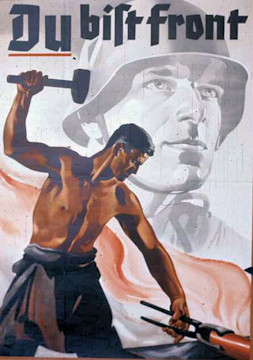
Like many who take a shine to the Third Reich (my fascination goes back 50 years), I’ve acquired the odd bit of historical detritus now and again: an Iron Cross here; a wound badge there; party-pins or Hitler Youth tinnies; a few armbands and flags. But I must confess having skipped over the more feminine awards. Let’s be honest, our perception of National Socialism, and certainly the National Socialist movement, is very masculine: the leading figures of the Third Reich and subsequent National Socialist efforts were all men; the founding political and ideological thinkers of National Socialism were men; even the imagery used to promote National Socialist values typical center on a strong male figure, usually in uniform or brandishing a weapon. It would be easy to assume that National Socialism is a man’s movement dedicated to the well-being of men exclusively, and that women in the National Socialist worldview are ignored or pushed to the background. This is an unfortunate assumption, because it simply isn’t true. Every honest National Socialist, up to and including Adolf Hitler himself, recognized the vital role women play in creating and preserving the White race and its culture.

The reason people make these erroneous assumptions is simple: they are looking at the world through the wrong lens. In our post-1960s-feminist society, there is no distinction between men and women. Not biologically and not socially. We have Marxist Jew Betty Friedan (née Goldstein), her book The Feminine Mystique, and the National Organization of Women (NOW, which she founded), to thank for this. What’s interesting, if not a little eerie, is that Hitler himself, in a 1934 speech to the National Socialist Women’s League, blamed Jewish intellectuals for the same problem in his day. As they say, nothing new under the sun.
Today, thanks to the overt efforts of mentally-ill Jewish feminists and their blind followers, men can have babies and go on maternity leave, women can transition into men, and our children are more confused than ever.
We National Socialists look at the relationship between men and women and the roles they play in a healthy society differently. We recognized there were only two sexes long before it was cool, because National Socialism follows the laws of nature. Nature itself has prescribed different roles for the male and the female. In short, men are fathers and women are mothers. It’s so patently obvious that it seems absurd to even have to say it. But such are the times.
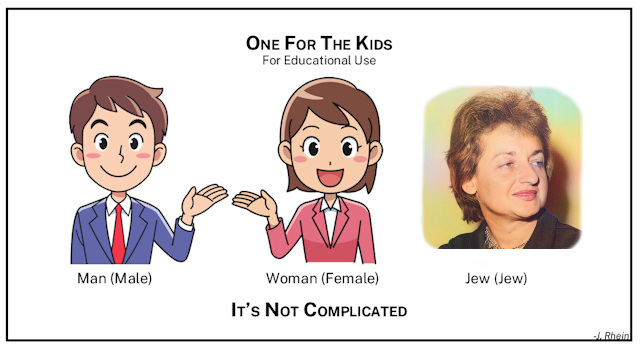
However, and this is crucial, the role of women in the National Socialist world was considered equal to, not lesser than, that of men. Women are never considered mere “baby factories”. In the National Socialist worldview, the woman’s world, if smaller in scope than the man’s—being focused as it is on the home instead of the national stage—provides the very foundation and stability on which everything else is built.
As Hitler himself said:
If the man’s world is said to be the State, his struggle, his readiness to devote his powers to the service of the community, then it may perhaps be said that the woman’s is a smaller world. For her world is her husband, her family, her children, and her home. But what would become of the greater world if there were no one to tend and care for the smaller one? How could the greater world survive if there were no one to make the cares of the smaller world the content of their lives? No, the greater world is built on the foundation of this smaller world. This great world cannot survive if the smaller world is not stable.
Providence has entrusted to the woman the cares of that world which is her very own, and only on the basis of this smaller world can the man’s world be formed and built up.”
~Adolf Hitler, Speech to the National Socialist Women’s League, September 8, 1934
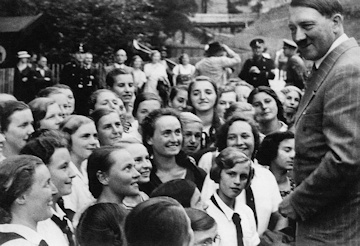
Not all women wanted to be mothers, of course. And many did not. This in no way diminished their role as members of the Volk: Many served as welfare workers, teachers, secretaries, nurses, and auxiliaries in the armed forces and police. But in a way, this speaks exactly to our point: in National Socialist Germany, unlike our “modern” society, motherhood was seen as an honored and equally valued choice (indeed, one could argue more so) when compared to any other “career path”.
How important were women in the Third Reich, and how highly regarded were those women who chose (and it was always a choice) to become mothers? Consider the award given to certain mothers by Germany during World War II: the Cross of Honor of the German Mother, colloquially known as the Mother’s Cross.
The Cross of Honor of the German Mother
The Cross of Honor of the German Mother (Ehrenkreuz der Deutschen Mutter, often simply referred to as the “Mother’s Cross”) was instituted by decree on December 16, 1938 to recognize the critical importance of motherhood in National Socialist Germany.
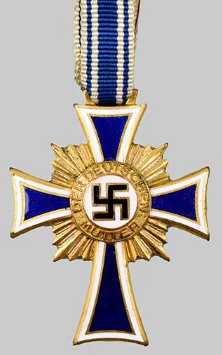
As a visible sign of gratitude of the German nation to children-rich mothers I establish this Cross of Honour of the German Mother.”- Adolf Hitler
Today there is growing concern about a declining population globally, nationally, and certainly among the White race— but that’s a topic for another day. However, Germany was facing this same problem in the 1930s: To fulfill the destiny of National Socialist Germany, it was vital that the population increase, both to populate the lands acquired as a result of the Lebensraum (territorial expansion) policy, and to strengthen the nation domestically and militarily. This concern was not unfounded. The number of live births in Germany was already declining precipitously before WWI, a result of industrialization and a growing world-wide “feminist” movement which eschewed or condemned motherhood and the traditional role of women in society in favor of childless women toiling away at wage work. The two-million German men killed during the Great War only exacerbated the problem.
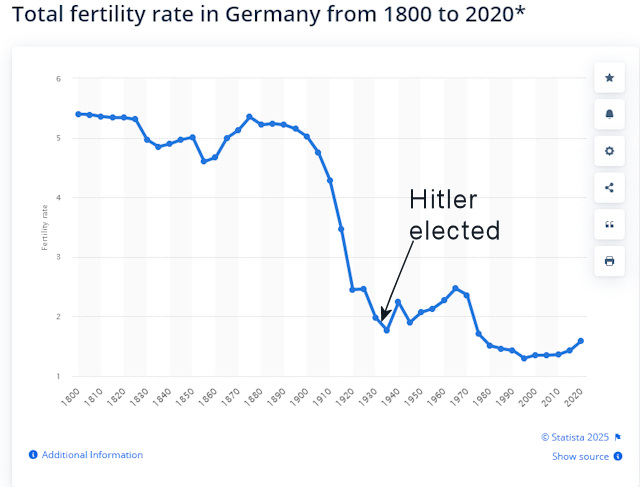
To address this challenge, National Socialist Germany hoped to restore the place of honor and recognition that motherhood plays in building a strong Volk. One way this was done was by creating the Mother’s Cross.
Generally the crosses were awarded annually on the second Sunday in May (Mothering Sunday or Mother’s Day), but also extended to include other national annual occasions of celebration. The award itself consisted of three grades:
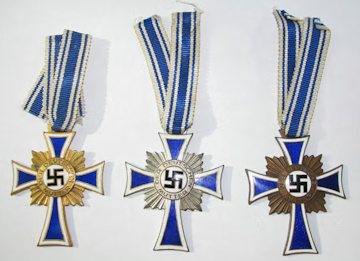
- 1st class, Gold Cross: eligible mothers with eight or more children (which sounds all but impossible now, given the global average of 2.1 children per woman, but was not at all unheard of in the farm-families of the past. My great-grandmother had nine children that survived childbirth)
- 2nd class, Silver Cross: eligible mothers with six or seven children
- 3rd class, Bronze Cross: eligible mothers with four or five children
But again, it wasn’t simply about being a “baby factory”.
Qualifications
Qualification for the award was no easy matter. Nomination could only be instigated by the local mayor’s office, the local NSDAP group leader, or the District Warden of the Reichs Union of Children-rich families (Reichsbund der Kinderreichen). The nomination then involved a review process that makes today’s procedure for gaining a national security clearance look easy: Not only was the prospective mother reviewed, but the backgrounds of the husband and the parents of both. Awarding the Mother’s Cross was so highly regarded that additional bureaucratic resources assigned to lesser civil and military decorations were pulled for the exhaustive administrative procedures that this decoration alone required. Local government agencies consulted included the Social Welfare Agency, Public Health Department, Youth Welfare Agency, as well as the Police.
The medal could and was only bestowed on the “most honorable proven mothers”. The prerequisites required were:
1) That both parents of the children were of German blood and genetically fit:
- a)Provide evidence of German blood-heredity;
- b)That the four grandparents of the children are not Jewish or other ethnic origin, nor belonged or subscribed to the Jewish religion;
2)That the mother of the decoration was ‘worthy’:
- a) Reputable moral standing, genetically healthy and fit;
- b) No evidence of confinement to a state penitentiary, marital infidelity, unlawful abortion, or other taboo or social offenses such as prostitution or promiscuous behavior;
- c) No evidence of intimate interracial relations (miscegenation)
3) That the children were live births:
- a) In addition, the children were free of hereditary illnesses or genetic disorders;
- b)Evidence that the family home was maintained to “acceptable and orderly standards” and to nurturing their children to be good Reich citizens;
- c) In addition, it was necessary that the husband not to have served a prison sentence,that the great number of children were not born for the purposes of fleecing the state child-support system, and that family members were not chronic alcoholics, work- shy, in conflict with the law, and that the family was not a burden on the private or public welfare system.
The official screening protocols also encouraged the local mayor’s office to consider whether the nominated mother had borne children likely to “bear sacrifices in the interest of preserving the German nation, or whether the children posed a burden and peril to the future of the German nation, and the children perhaps should have better remained unborn.”
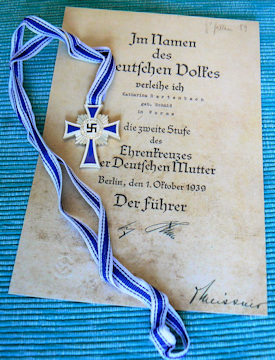
Privileges
As might be expected, having cleared these not undaunting hurdles, the mother awarded the Cross of Honor was held in the highest esteem and enjoyed certain benefits and privileges. They received preferential treatment and priority in society and public services. Wherever possible, they received the best housing, food, clothing, and schooling for their children. They received the best cuts of meat at the butcher shop. Members of the Hitler Youth were instructed to salute those wearing the Mother’s Cross. During the war years, when all other civil honors and decorations were temporarily suspended to preserve manpower and resources, the Mother’s Cross continued to be awarded until the very last day, May 8, 1945.
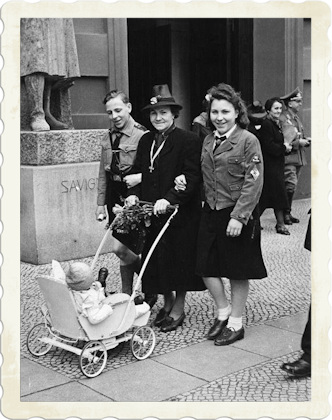
It is telling that when West Germany passed it’s law in 1957 on the redesign and wearing of medals awarded during the National Socialist years (that is, removing the swastika from them), the Cross of Honor of the German Mother was not included. No longer allowed to be displayed in Germany at all, one wonders how many are tucked discreetly in the back of the dresser drawer, and what stories about them will be quietly whispered from mother to daughter in the generations to come.
That is, until such a time as we National Socialists can again remind the world of the vital role women as mothers and wives play in the health and welfare of our world. In the parlance of the Orangeman, National Socialists want to erase the Jewish asexual hogwash filling the minds of our people today, and Make Women Great Again in the eyes of our White culture. If I’m out relic shopping and stumble upon a Mother’s Cross, I’ll be sure to scoop it up. Who knows? Maybe I’ll have occasion to give it to one of my daughters someday.
Happy Mother’s Day.
Amerika Erwache!
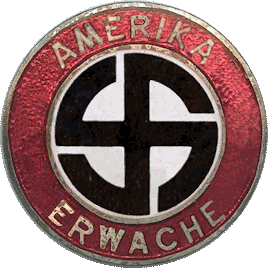
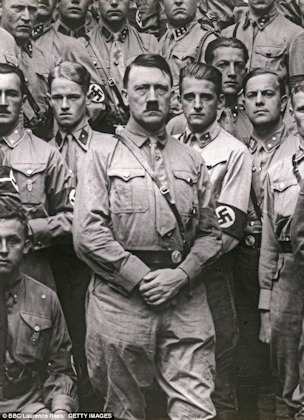
Leave a Reply